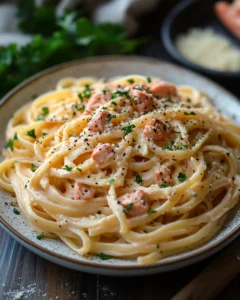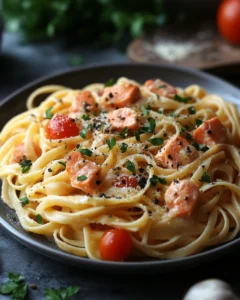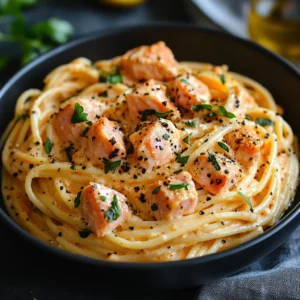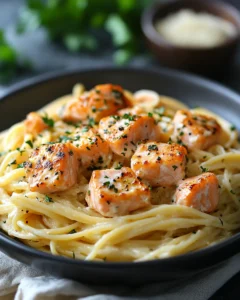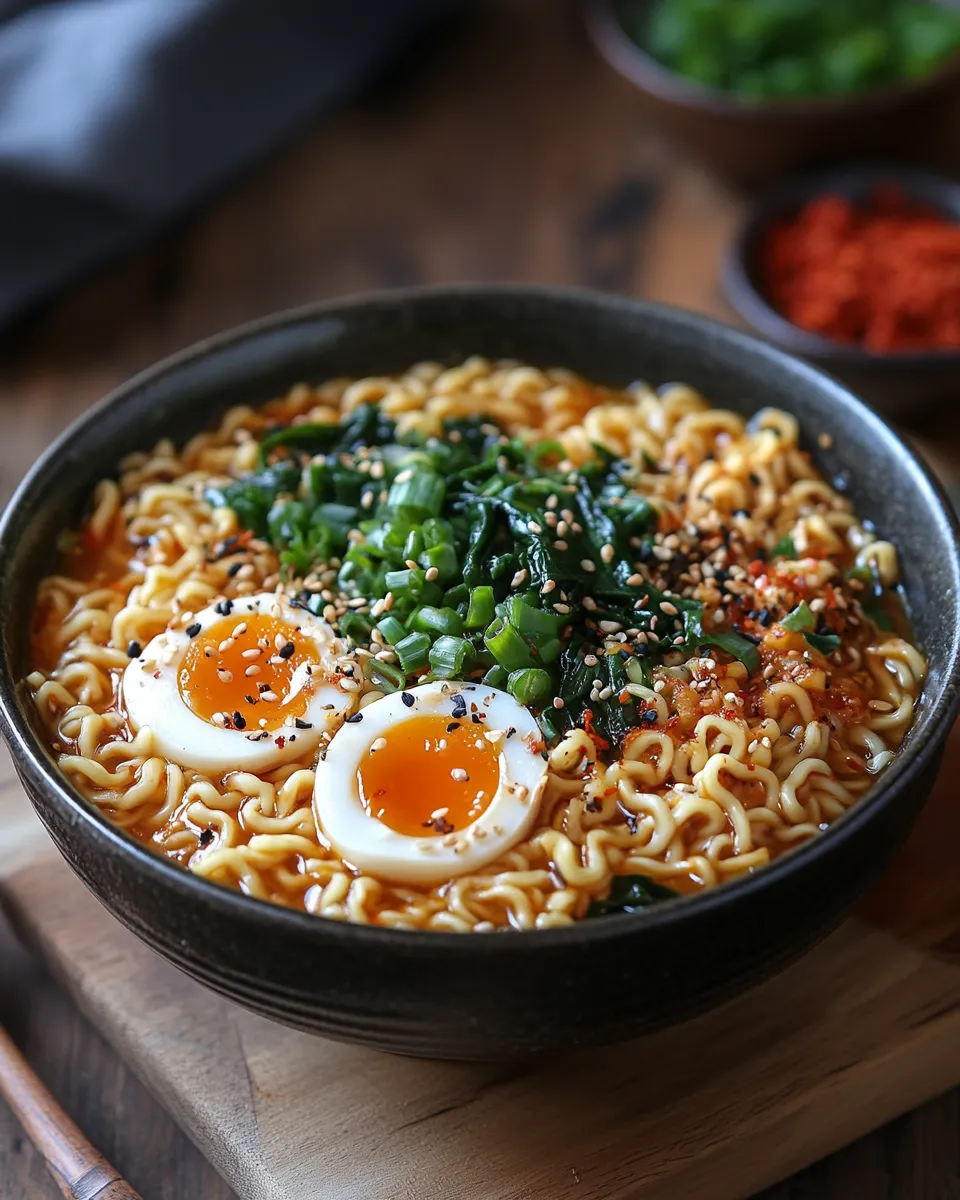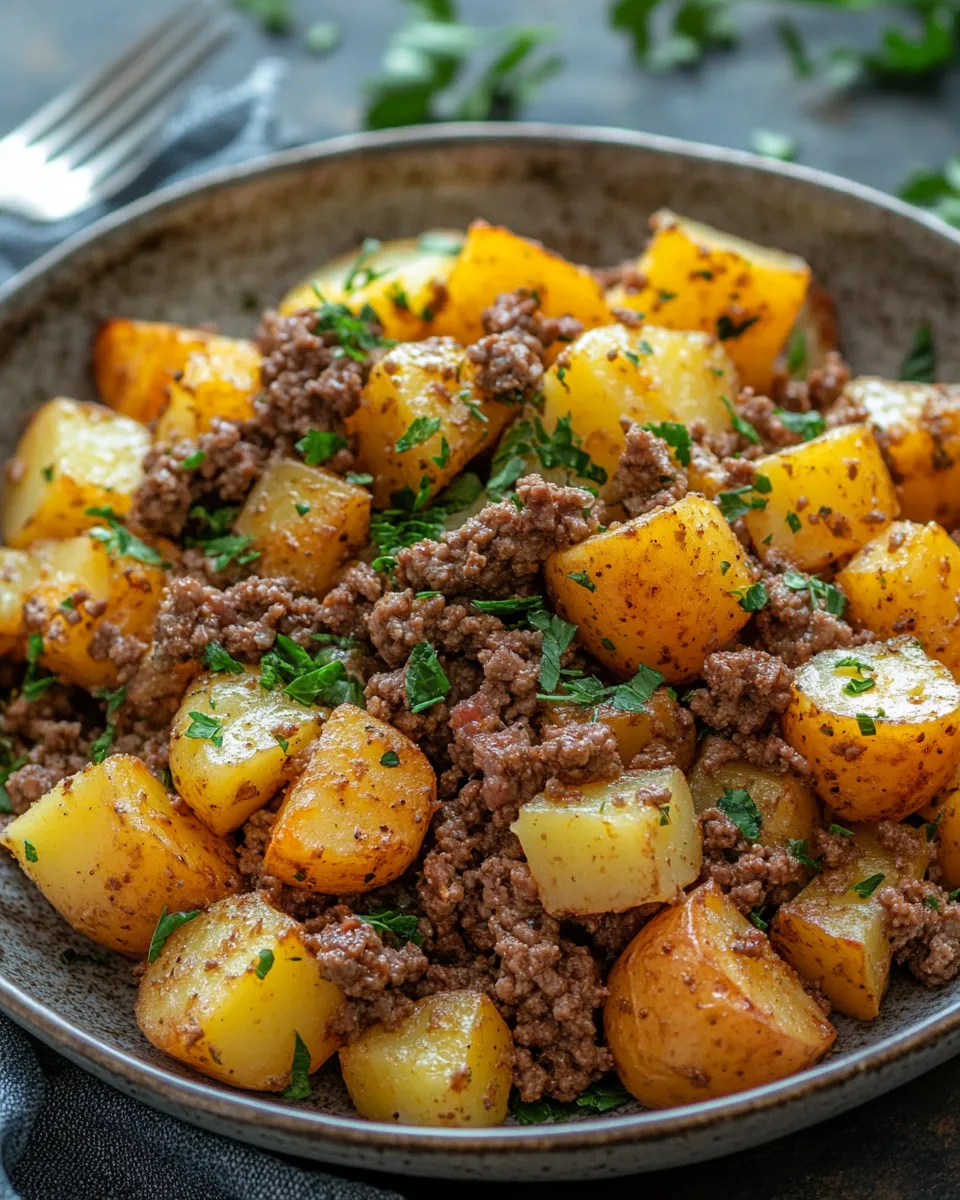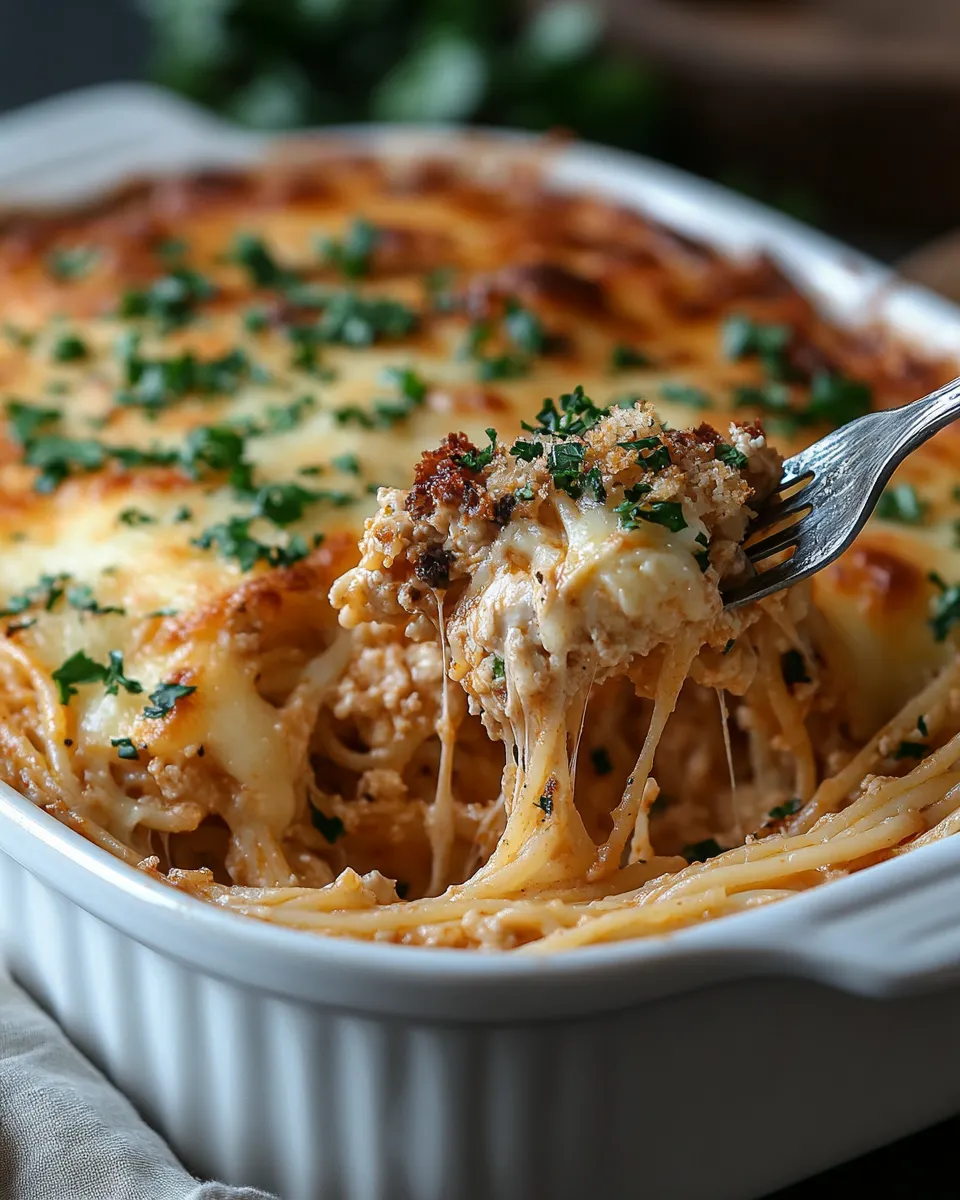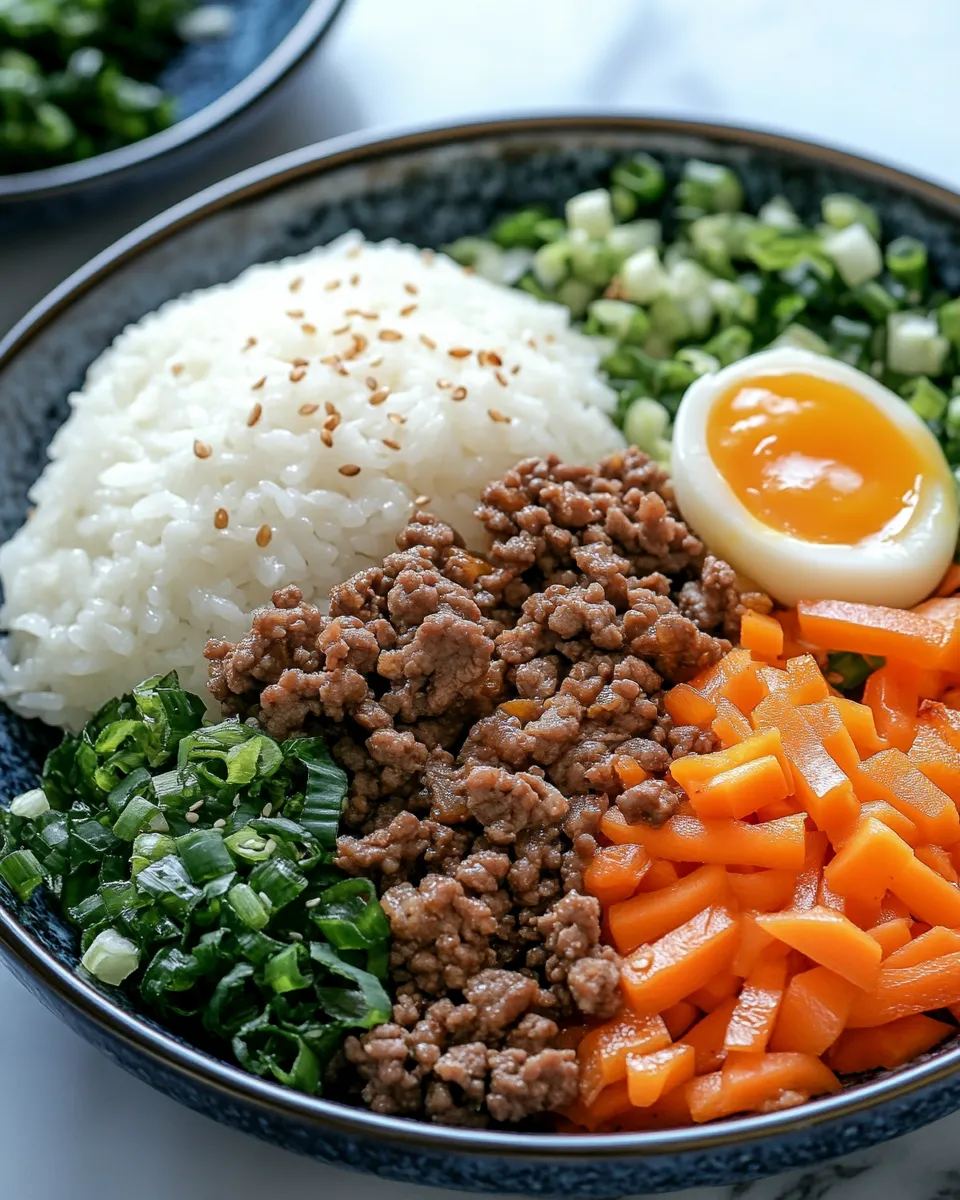A Comforting Classic For Busy Weeknights
There’s something magical about a warm bowl of creamy salmon pasta after a long day. Maybe it’s the velvety sauce that hugs each noodle, or the tender, flaky bites of salmon that melt in your mouth. Either way, this is the kind of meal that feels like a treat—yet it comes together in just 25 minutes.
This recipe was born out of a chilly Friday night craving for something indulgent but easy. With a few fridge staples and a fresh salmon fillet from the market, the result was a comforting, restaurant-quality dish that instantly became a family favorite. Whether you’re feeding loved ones or treating yourself to a solo dinner, this creamy salmon pasta hits all the right notes.
Why You’ll Love This Creamy Salmon Pasta
-
Ready in under 30 minutes – Perfect for weeknights
-
Rich and satisfying – Creamy without being too heavy
-
Customizable – Swap out the pasta or add greens
-
Elegant yet easy – Feels fancy, cooks fast
Ingredients You’ll Need
Before we dive into the steps, let’s take a quick look at what you’ll need for this recipe. Most of these are pantry or fridge staples, making it even more convenient.
For the Salmon:
-
2 salmon fillets (skinless or skin-on, about 6 oz each)
-
Salt and black pepper, to taste
-
1 tablespoon olive oil
-
1 teaspoon garlic powder (optional)
For the Pasta:
-
8 oz fettuccine, linguine, or penne
-
Salted water for boiling
For the Cream Sauce:
-
2 tablespoons unsalted butter
-
3 cloves garlic, minced
-
½ small onion, finely diced
-
1 cup heavy cream (or half-and-half for a lighter version)
-
½ cup freshly grated Parmesan cheese
-
Zest of 1 lemon
-
1 tablespoon lemon juice
-
Salt and black pepper to taste
-
1 teaspoon dried dill or 1 tablespoon fresh dill
-
¼ teaspoon red pepper flakes (optional)
Garnish:
-
Chopped parsley or basil
-
Extra lemon zest or Parmesan
Step-by-Step Instructions
Follow these detailed instructions to bring this creamy salmon pasta recipe to life. The entire dish comes together quickly, so it’s a good idea to prep and measure your ingredients beforehand. Multitasking is key here—you can prepare the salmon and the sauce while the pasta is boiling, making it a true 25-minute meal.
1. Cook the Pasta
Start by bringing a large pot of salted water to a rolling boil. Salt is crucial here—it’s your first chance to season the pasta from the inside out. For 8 ounces of pasta, aim to use about 1 tablespoon of salt.
Once the water is boiling, add your pasta of choice. Fettuccine, linguine, spaghetti, or penne all work beautifully with the creamy sauce. Cook the pasta according to the package directions until it’s just al dente—tender but with a slight bite.
Before draining, carefully scoop out about ½ cup of the starchy pasta water using a heatproof measuring cup or ladle. This reserved water will help loosen the sauce later and give it that silky, restaurant-style finish. Drain the pasta and set it aside, keeping it warm.
2. Cook the Salmon
While the pasta is cooking, it’s time to prepare the salmon. Pat the fillets dry with a paper towel to help them sear nicely in the pan. Season both sides generously with salt and freshly cracked black pepper. You can also add a touch of garlic powder for an extra layer of flavor.
Heat the olive oil in a large skillet over medium-high heat. Once the oil is hot and shimmering, gently lay the salmon fillets in the pan, skin-side down if applicable. Let them cook undisturbed for about 3 to 4 minutes per side. You’re aiming for a nice golden sear on the outside and moist, flaky flesh inside.
Use a fork to check for doneness—the salmon should flake easily when gently prodded. Once cooked, transfer the fillets to a clean plate and allow them to rest for a minute. Then, using two forks or your fingers, flake the salmon into large, bite-sized chunks. If there’s any skin, remove and discard it.
3. Make the Creamy Garlic Sauce
Using the same skillet (don’t clean it—you want all those flavorful bits left by the salmon), reduce the heat to medium. Add the butter and let it melt completely.
Next, toss in the finely chopped onion and minced garlic. Sauté for about 2 to 3 minutes, stirring frequently, until the onions turn translucent and the garlic is fragrant. Be careful not to let the garlic brown, as it can become bitter.
Slowly pour in the heavy cream while stirring continuously. Add the lemon zest and juice to brighten the sauce and balance the richness of the cream. Let the mixture simmer gently for 3 to 5 minutes so it thickens slightly.
Stir in the Parmesan cheese until it melts completely into the sauce. The sauce should be velvety and smooth. Season with salt, pepper, a pinch of red pepper flakes if you like a little heat, and dill for a herby finish.
4. Combine Everything
Once the sauce is ready, add the cooked pasta directly into the skillet. Use tongs or a pasta spoon to toss the noodles gently in the creamy sauce, making sure each strand is coated. If the sauce feels too thick, stir in a splash or two of the reserved pasta water to loosen it.
Now, add the flaked salmon back into the skillet. Use a soft hand to fold it into the pasta so the delicate pieces don’t fall apart completely. The goal is to have noticeable, tender chunks of salmon in every bite.
Let everything heat through for another minute or two, just until the salmon is warmed again and the pasta has fully absorbed the flavors of the sauce.
5. Serve and Enjoy
Your creamy salmon pasta is ready to plate. Serve it hot, directly from the skillet or transferred into a serving dish.
Garnish with a sprinkle of chopped fresh parsley or basil for a pop of color and freshness. Add extra Parmesan on top, along with a pinch of lemon zest for brightness.
This dish is best enjoyed immediately, when the sauce is silky, the salmon is tender, and every bite feels like a comforting indulgence.
Tips For The Best Creamy Salmon Pasta
-
Use fresh salmon for the best flavor and texture, but canned or leftover cooked salmon can work in a pinch.
-
Don’t overcook the salmon – it should just flake easily and remain moist.
-
Grate your own Parmesan – pre-shredded cheese doesn’t melt as smoothly.
-
Reserve pasta water – this helps emulsify the sauce and makes it extra silky.
-
Adjust lemon to taste – add more juice or zest if you love that bright citrus kick.
Ingredient Substitutions & Variations
This recipe is very flexible, making it easy to adapt based on what you have on hand.
Pasta Options
-
Fettuccine, linguine, spaghetti, or tagliatelle all work beautifully.
-
Use gluten-free pasta or whole wheat for a healthier version.
Cream Alternatives
-
Substitute heavy cream with half-and-half or full-fat coconut milk for a dairy-free option.
Add-Ins
-
Baby spinach, cherry tomatoes, peas, or asparagus can be stirred in for added nutrition and color.
-
Crumbled feta or goat cheese can offer a tangy twist.
Protein Swaps
-
Try cooked shrimp, crab meat, or chicken instead of salmon.
Storage & Reheating Tips
This creamy salmon pasta stores well, though it’s best enjoyed fresh. Here’s how to handle leftovers:
Storage:
Store leftovers in an airtight container in the refrigerator for up to 2 days.
Reheating:
Reheat gently in a pan over medium-low heat, adding a splash of milk or broth to bring back the creaminess. Avoid microwaving if possible, as it can overcook the salmon and split the sauce.
Serving Suggestions
Pair this dish with:
-
A simple green salad with lemon vinaigrette
-
Garlic bread or crusty sourdough
-
Roasted veggies like broccoli, asparagus, or zucchini
-
A glass of white wine such as Pinot Grigio or Sauvignon Blanc
Frequently Asked Questions
Can I use canned salmon instead of fresh?
Yes, absolutely. Canned salmon is a convenient and budget-friendly alternative to fresh fillets. It can be especially handy for busy weeknights or when fresh fish isn’t available. Just be sure to drain the salmon thoroughly to avoid watering down the sauce. Also, take a moment to remove any small bones or pieces of skin if they’re present. Once prepped, flake the salmon gently with a fork and fold it into the cream sauce as you would with fresh. While the flavor and texture won’t be exactly the same, canned salmon still creates a delicious, satisfying result.
Can I make it ahead of time?
Yes, this recipe can be partially prepared in advance to save time later. You can cook the salmon and make the creamy sauce ahead of time—just store them in separate airtight containers in the refrigerator. When you’re ready to eat, simply reheat the sauce slowly over medium-low heat, stirring often to keep it smooth. Add a splash of cream or milk if the sauce has thickened too much. Cook the pasta fresh, then combine everything just before serving. This approach helps preserve the texture and prevents the pasta from getting soggy.
Is this recipe kid-friendly?
Absolutely. This creamy salmon pasta is mild in flavor and comforting in texture, which makes it appealing to younger eaters. The richness of the cream sauce and the subtle flavor of the salmon are usually a hit with kids. If you’re cooking for particularly picky eaters, consider leaving out the red pepper flakes or lemon zest, which can add a sharper note. You can also serve the pasta with grated cheese on the side so each child can customize their bowl to taste.
Can I freeze creamy salmon pasta?
Freezing this dish isn’t recommended. The creamy sauce can separate and become grainy when thawed, and the salmon may take on a mushy texture. For the best taste and texture, enjoy this pasta freshly made or store leftovers in the refrigerator for up to two days. Reheat gently on the stovetop with a splash of cream or milk to bring the sauce back to life.
How do I make it more lemony?
If you love bright citrus flavors, you can easily dial up the lemon in this dish. Add more lemon zest for aroma and tang, or squeeze a bit of extra lemon juice into the sauce right before serving. Fresh dill also pairs beautifully with lemon and adds a refreshing, herby touch.

